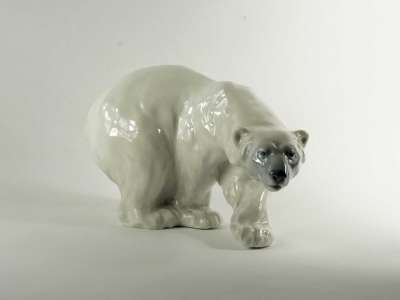This elegant French ceramic sculpture, crafted by renowned designer Georges Henri Laurent, captures a touching moment between a doe and her fawn. Created circa 1930, this piece reflects the Art Deco movement's distinctive style, showcasing gently stylised forms. Laurent, active during the early 20th century, was known for his animal sculptures, producing works for acclaimed companies such as Robj, Süsse Frères, and Dunhill. This particular sculpture bears his signature, 'G. H. Laurent', marking its authenticity. With its serene expression and fluid lines, it is a testament to Laurent's ability to capture the essence of his animal subjects. The sculpture hails from France, embodying the country's rich tradition of ceramic artistry.
Condition Report
The sculpture is in very good condition, with wear consistent with its age and use over the decades. The surface displays minor patina, which is typical for ceramics from this period, adding character to the piece without detracting from its visual appeal. There are no significant chips or cracks, indicating that it has been well-preserved. The base of the sculpture remains intact, ensuring its stability. Overall, the wear is minimal and does not affect the intricate detailing that characterises this work, making it a desirable addition to any collection.
Dimensions
Weight: 845gm, Length: 10cm, Width: 18cm, Height: 28cm.
A Sculpture for Artistic Appreciation
The original intended use of this ceramic sculpture was purely decorative, designed to serve as a centrepiece within a domestic setting. It reflects the Art Deco period's emphasis on form and aesthetic appeal, making it an ideal object for display. Whether placed on a mantelpiece, a side table, or within a glass cabinet, it invites admiration and contemplation, enhancing the ambiance of any room with its grace and historical significance.
Art Deco Influence in Form
This sculpture is a fine example of Art Deco design, a style characterised by its use of geometric shapes and streamlined forms. Originating in the early 20th century, Art Deco merged modernist styles with fine craftsmanship and rich materials. Georges Henri Laurent's work often embraced these principles, as seen in the stylised yet naturalistic portrayal of the doe and fawn. The sculpture's smooth curves and elegant proportions embody the balance between modernity and tradition, a hallmark of the Art Deco era. Its presence is understated yet compelling, making it a versatile piece that complements both contemporary and traditional interiors.
Craftsmanship in Ceramic Artistry
The sculpture exemplifies the meticulous craftsmanship associated with ceramic artistry during the Art Deco period. Created using high-quality clay, the piece would have been shaped, sculpted, and fired in a kiln at high temperatures to ensure durability. The white glaze finish highlights the sculpture's smooth surfaces and intricate details, such as the delicate expressions of the animals. The process required a skilled hand and a deep understanding of the materials, reflecting Laurent's expertise as a sculptor and his attention to detail. Such craftsmanship not only captures the beauty of the subjects but also ensures the piece's longevity.
Georges Henri Laurent's Legacy
Georges Henri Laurent was a prominent figure in the Art Deco movement, celebrated for his animal-themed sculptures. Born in 1880, Laurent developed a distinct style that combined realistic elements with artistic abstraction. His collaborations with notable entities like Robj and Süsse Frères positioned him at the forefront of decorative arts. Laurent's work is characterised by its attention to form and detail, with an emphasis on capturing the essence of his subjects. This sculpture of a doe and fawn is indicative of his skill and artistic vision, making it a valuable artefact from his oeuvre.
A Coveted Piece for Collectors
Collectors of Art Deco pieces are often drawn to Laurent's works due to their artistic merit and historical significance. The era marked a significant shift in design philosophy, and Laurent's sculptures serve as a bridge between traditional craftsmanship and modern artistic expression. This particular sculpture, with its graceful depiction of animal subjects, appeals to collectors interested in the natural world and the Art Deco movement. Pieces like this are cherished for their ability to capture the spirit of an era, making them sought-after additions to both private collections and public exhibitions.
















